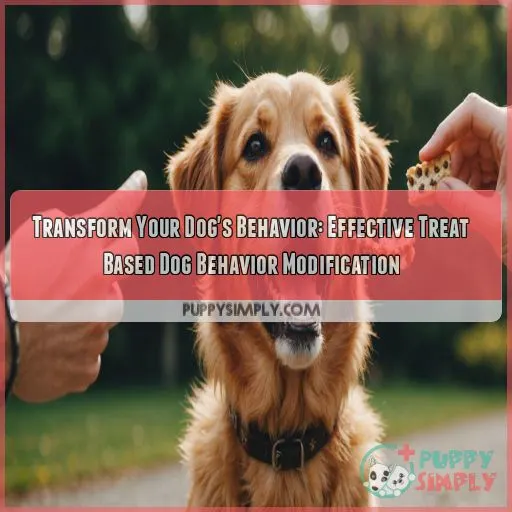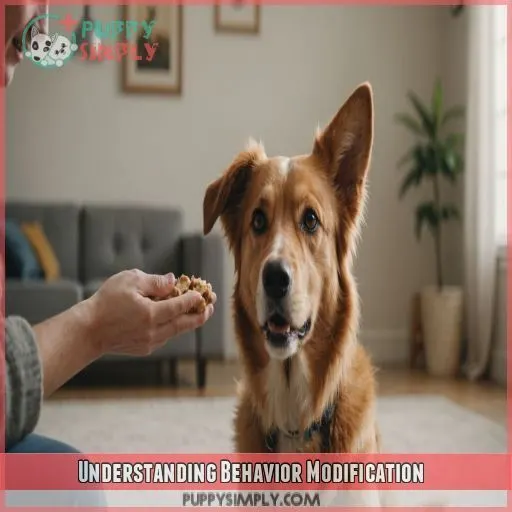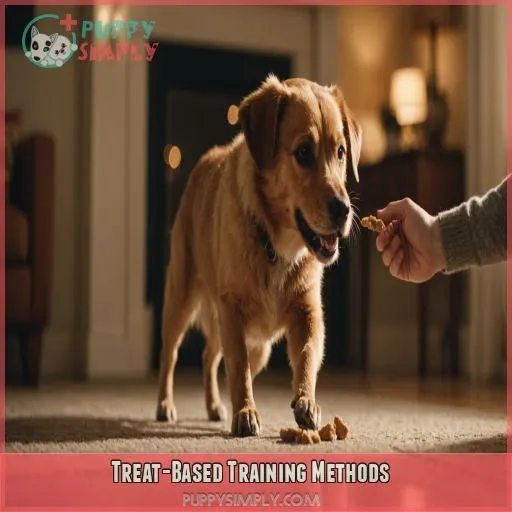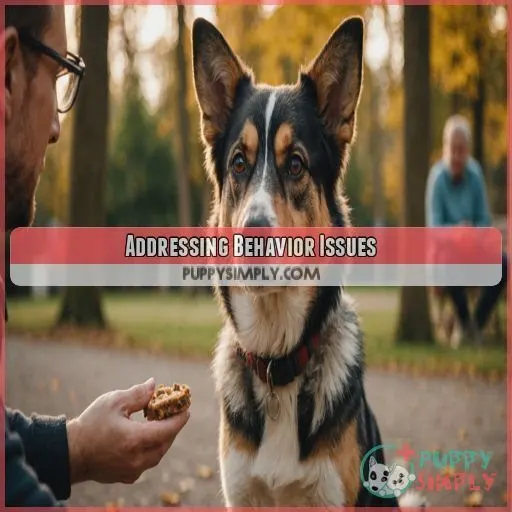This site is supported by our readers. We may earn a commission, at no cost to you, if you purchase through links.

Treat-based dog behavior modification is a game-changer!
By using tasty rewards, you can teach your furry friend to ditch unwanted habits like leash pulling, anxiety, and fear-based reactions.
With positive reinforcement techniques, you’ll be empowering your dog to make good choices, not just masking the bad ones.
It’s all about associating desired behaviors with yummy treats, then gradually phasing them out.
With patience and consistency, you’ll be amazed at the progress you can make.
And, with the right approach, you’ll be saying goodbye to bad behavior in no time – and hello to a happier, healthier pup!
Table Of Contents
- Key Takeaways
- Choosing the Right Trainer
- Understanding Behavior Modification
- Treat-Based Training Methods
- Addressing Behavior Issues
- Effective Use of Treats
- Overcoming Challenges and Setbacks
- Frequently Asked Questions (FAQs)
- What are the behavioral modification techniques for dogs?
- Which form of behavior modification techniques is inappropriate to use to treat aggression?
- How do you train a dog with treats psychology?
- What is the best method of dealing with a dog’s behavioral issues?
- How long does it take to modify a behavior?
- Can I use treats for large breed dogs too?
- What if my dog is not food motivated?
- How do I transition from treats to life rewards?
- Can I combine treat-based training with other methods?
- Conclusion
Key Takeaways
- When it comes to transforming your dog’s behavior, treat-based modification is the way to go – it’s a total game-changer! By associating desired behaviors with tasty rewards, you’ll be empowering your dog to make good choices, not just masking the bad ones.
- Remember, finding the right trainer is like finding a needle in a haystack – it’s super important, and you want someone who uses positive reinforcement, has experience with your dog’s specific issues, and makes both you and your furry friend feel relaxed and confident.
- Before diving into behavior modification, it’s essential to understand why your dog behaves a certain way – are they attention-seeking, resource-guarding, or fear-based? Knowing the root cause helps you address the real issue, rather than just treating the symptoms.
- Be patient and celebrate small victories – modifying behavior takes time, and it’s normal to encounter setbacks along the way. Consistency is key, so stick to your plan, and don’t be afraid to seek help from dog behavior management pros if you need it.
Choosing the Right Trainer
Finding the right trainer is super important when you want to change your dog’s behavior – it’s not just anyone with treats and a smile. You want a trainer who uses positive reinforcement, has experience with your dog’s specific issues, and makes both you and your furry friend feel relaxed and confident.
Guidelines for Selecting a Dog Trainer
Choosing the right dog trainer can be overwhelming. Look for qualifications, experience, and a clear understanding of ethics. A good trainer communicates effectively and provides references. As you shop around, watch for red flags like guarantees or punitive methods. You want a partner who helps you understand your dog’s behavior, not a quick fix. Prioritize your dog’s comfort and well-being.
Importance of Positive Reinforcement
When choosing a trainer, prioritize positive reinforcement. This approach focuses on rewarding desired behaviors, rather than punishing undesired ones. Here are three key benefits:
- Building trust: Positive reinforcement fosters a strong bond between you and your dog.
- Alternatives to treats: You can use praise, play, and affection as rewards, too.
- Long-term effects: Positive reinforcement leads to lasting behavior change, without fear or anxiety.
Red Flags to Watch Out for in Trainers
When searching for a trainer, watch out for red flags like punishment-based methods, guaranteed results, or a lack of credentials. Be wary if they ignore your concerns or offer unsolicited advice. A good trainer will prioritize your dog’s well-being and work with you to develop a personalized plan. Don’t settle for anything less in your dog’s behavior modification journey.
Understanding Behavior Modification
You’re about to start a journey to change your dog’s behavior, and it begins with understanding the basics of behavior modification. By grasping how your dog learns and responds to their environment, you’ll be equipped with the tools to tackle even the most challenging behaviors and strengthen your bond with your furry friend.
Definition and Scope of Behavior Modification
Now that you’ve chosen the right trainer, let’s get started with behavior modification! It’s a treatment approach that changes undesirable behaviors in dogs, tackling issues from leash pulling to aggression. By focusing on rewarding desired behaviors with positive reinforcement, you can modify your dog’s behavior and strengthen your bond. Think of it as upgrading your dog’s behavior software.
Types of Consequences in Behavior Modification
Now that you know what behavior modification is, let’s talk about the consequences that can change your dog’s behavior. There are four types:
- Positive Reinforcement: Adding something good to increase a behavior (like treats for sitting).
- Negative Reinforcement: Removing something bad to increase a behavior (like stopping a loud noise).
- Positive Punishment: Adding something bad to decrease a behavior (like scolding for barking).
- Negative Punishment: Removing something good to decrease a behavior (like taking away a toy).
These consequences can make or break your dog’s behavior, so use them wisely!
Functions of Behavior in Dogs
Understanding why your dog behaves a certain way is key to changing it. Is your dog attention-seeking, resource-guarding, or fear-based? Do they suffer from separation anxiety or territoriality? Knowing the function of their behavior helps you address the root cause. It’s like solving a puzzle, and applied behavior analysis is the key to figuring out a better-behaved dog.
Treat-Based Training Methods
You’re about to become a treat-wielding ninja, using the power of positive reinforcement to transform your dog’s behavior. With treat-based training methods, you’ll learn how to harness the magic of rewards to encourage good behavior, calm fears, and strengthen your bond with your furry friend.
Positive Reinforcement Techniques
Now that you understand behavior modification, let’s get hands-on with positive reinforcement techniques!
Treat-based training is a game-changer.
Clicker training, reward schedules, and perfecting reinforcement timing can make your dog a pro.
But remember, treats aren’t the only way to go – praise, affection, and play can be just as effective.
Get creative and find what works best for your furry friend!
Classical Conditioning and Counterconditioning
Now that you’ve got a handle on positive reinforcement, let’s explore classical conditioning and counterconditioning. This powerful duo can help your dog overcome fear and anxiety. Here are 4 ways to make it work:
- Associate good things: Pair something pleasant with a feared stimulus.
- Neutralize the trigger: Gradually reduce the fear response.
- Counter with calm: Replace anxiety with relaxation.
- Consistency is key: Make it a regular practice.
Desensitization and Systematic Desensitization
Let’s tackle desensitization and systematic desensitization. You want to help your dog overcome fears or anxiety? Gradual exposure is key! Break the scary thing into manageable bits, then reward calm behavior. Repeat, repeat, repeat!
| Desensitization Step | What to Do | What to Avoid |
|---|---|---|
| Identify the Trigger | Pinpoint what scares your dog | Overwhelming them with too much, too soon |
| Start Small | Begin with low-level exposure | Rushing the process |
| Reward Calm Behavior | Treats, praise, and affection | Ignoring or punishing fear |
| Increase Exposure | Gradually up the ante | Pushing too hard, too fast |
Addressing Behavior Issues
When you’re dealing with behavior issues in your dog, it’s important to figure out what’s really going on instead of just treating the symptoms. By understanding the root cause of your dog’s behavior, you can create a personalized plan to help them become a happier, healthier companion.
Common Behavior Issues in Dogs
You’re probably no stranger to the frustration of dealing with common behavior issues in dogs, like leash pulling, excessive barking, or even aggression. Anxiety and separation anxiety can also be overwhelming for both you and your furry friend. Don’t worry, with effective dog behavior modification, you can tackle these issues head-on and find peace again.
Identifying and Addressing Underlying Causes
Now that we’ve covered common behavior issues, let’s talk about identifying the underlying causes. It’s like being a detective for your dog’s behavior! Consider factors like dog anxiety, fear triggers, medical concerns, breed traits, and past experiences. Consult a dog behavior modification expert to help you crack the code and develop a plan to address these underlying issues.
Developing a Customized Behavior Modification Plan
Now that you’ve identified the underlying causes of your dog’s behavior issues, it’s time to create a customized behavior modification plan.
Set specific dog behavior goals and structure your training plan with achievable milestones.
As the owner, your involvement is really important – you’ll be monitoring progress and making plan adjustments as needed, ideally under the guidance of dog behavior management professionals.
Effective Use of Treats
Training your dog with treats? Choosing the right ones and using them smartly is key to making it work. By picking treats your dog loves and consistently rewarding good behavior, you can help them learn new tricks and overcome any issues they might have. It’s a win-win, setting you both up for a happier, healthier relationship (Source).
How to Choose the Right Treats for Training
When choosing treats for training, consider your dog’s preferences and dietary needs.
Opt for small, low-calorie treats that are easy to chew and swallow.
Mix up the type and texture to keep things interesting.
Aim for a variety of 5-10 treats per session.
Rotate them regularly to avoid boredom.
Make it fun and engaging – your dog’s behavior resolution depends on it!
Timing and Consistency in Rewarding Behavior
Timing is everything" when rewarding your dog’s good behavior! Deliver treats within a 2-3 second window after the desired action. Consistency is key, so stick to a schedule. Reward frequency can impact effectiveness. Vary treat delivery to keep your dog engaged. A well-planned reward schedule can make all the difference in successful dog behavior management.
Phasing Out Treats in Training
The treat-phasing dance! You’ve used treats to teach new behaviors, but now it’s time to wean your dog off them. Gradually reduce treats by introducing reward alternatives, like praise or playtime. This motivation shift helps your dog learn to obey without expecting a snack. Aim for treat-free training and make your dog’s behavior more resilient.
Overcoming Challenges and Setbacks
You’re cruising along with your dog’s behavior modification plan, and then – boom! – you hit a roadblock, and your pup’s progress stalls. Don’t worry, it’s normal; setbacks happen, but with the right strategies, you can overcome them and get your furry friend back on track.
Dealing With Resistance to Change
Don’t fret when your dog resists change – it’s normal! As a dog owner, you’ve likely faced frustration when training setbacks occur. Remember, consistency matters, and patience is key. Rewarding effort, not just success, can help your dog overcome anxiety, fear, and phobias. Consider consulting dog behavior management counselors or change agents for personalized guidance. (Source)
Managing Setbacks and Regression
Don’t be too hard on yourself (or your dog) when setbacks happen. Regression is a normal part of the learning process. Dog behavior management researchers agree that consistency, motivation, and patience are key to getting back on track. Troubleshoot what went wrong, adjust your approach, and remember that every small step forward is still progress!
Maintaining Progress and Preventing Relapse
You’ve made it through the tough part – now it’s time to maintain that progress and prevent relapse.
Consistency is key.
Continue rewarding good behavior, and find ways to keep your dog motivated.
Surround yourself with supportive people, and don’t be afraid to seek help from dog behavior management communities or scientists if you need it.
With time, patience, and practice, you’ll be a pro at dog behavior management.
Frequently Asked Questions (FAQs)
What are the behavioral modification techniques for dogs?
Let’s talk about changing your dog’s behavior. You’ve got a few tricks up your sleeve! You can try habituation, desensitization, counterconditioning, positive reinforcement, and extinction – all evidence-based techniques to help your furry friend become a better-behaved buddy.
Which form of behavior modification techniques is inappropriate to use to treat aggression?
When dealing with aggression, avoid using punishment-based techniques, like positive punishment or aversive conditioning, as they can escalate the situation and create more fear, rather use reward-based techniques to encourage calm behavior.
How do you train a dog with treats psychology?
Imagine your dog’s tail wagging excitedly as you hold a treat! To train with treats, start by associating rewards with desired behaviors, like ‘sit’ or ‘stay.’ As your dog learns, phase out treats and use praise and affection as motivators.
What is the best method of dealing with a dog’s behavioral issues?
You want to tackle your dog’s behavioral issues, but where do you start? Begin by identifying the problem behavior, then work with a certified trainer to develop a customized plan using positive reinforcement techniques (Source).
How long does it take to modify a behavior?
You want to see progress, but behavior modification timelines vary depending on the issue’s complexity, your dog’s learning style, and consistency of training. Be patient, as it can take anywhere from weeks to months to achieve lasting change.
Can I use treats for large breed dogs too?
You can use treats for large breed dogs, too! Just be sure to choose low-calorie, healthy options to avoid overfeeding. Large dogs have big appetites, but their waistlines will thank you for keeping treats in check.
What if my dog is not food motivated?
Don’t worry if your dog isn’t food motivated – you can try using play or affection as rewards instead. Experiment with different motivators to find what gets your dog excited and engaged, and use that to your advantage.
How do I transition from treats to life rewards?
Switching from treats to life rewards – a big step in your dog’s training! Think of treats as training wheels, and life rewards as the freedom to ride without them. As your dog learns new skills, slowly replace treats with life rewards.
Can I combine treat-based training with other methods?
You can mix treat-based training with other methods, but be mindful of potential conflicts. Pairing treats with Clicker Training or positive reinforcement can be powerful, but avoid combining with punitive or aversive methods, as they can undermine progress.
Conclusion
Treats can be a powerful tool to change your dog’s behavior – it’s a win-win!
By using treats to train your dog, you can help them learn new behaviors and break bad habits.
It’s all about giving your dog the tools to make good choices.
With patience, consistency, and the right approach, you can say goodbye to bad behavior and hello to a happier, healthier pup.
Treat-based dog behavior modification can help you build a stronger bond with your furry friend.












